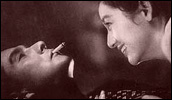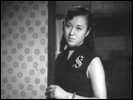Repast
- Year
- 1951
- Original title
- Meshi
- Japanese title
- 飯
- Director
- Cast
- Running time
- 97 minutes
- Published
- 11 February 2007



by Jasper Sharp
My Christmas climaxed a fortnight early when the padded envelope containing Eureka's new 3-disk box of Mikio Naruse titles flopped through the letterbox and onto my doormat. From then on my family pretty much had no chance, poor souls - there was simply no way anyone was going to give me anything else over the festive period that was going to better it.
Containing the 1954 adaptation of Yasunari Kawabata's Sound of the Mountain (Yama no Oto), the geisha drama Flowing (Nagareru, 1956), and the earliest film of the trio and the one under scrutiny here, Repast (1951), Eureka's release represents the first for this particular director for the UK home viewing market, although the French seem to be rather better abreast of things, with the Wild Side 'coffret' seeing Repast (or 'Le Repas' in French) joined by Naruse's first colour title, Summer Clouds (Iwashigumo, 1958), and what is consensually referred to as his finest, Floating Clouds (Ukigumo, 1955).
Great news then that Eureka's package comes auspiciously labelled as "Volume 1", suggesting that further goodies lie round the corner, and in fact, 2007 indeed looks like a year in which this particularly director's name seems set to spread across a good deal more lips than it hitherto has been, in Britain at least, with a touring program that has so far played a number of venues in the US finally making it to the NFT in London and Criterion's February release of When a Woman Ascends the Stairs (Onna ga Kaidan o Agaru Toki, 1960) being just two events to jot down in the calendar.
Naruse, who made ninety or so works between 1930 and his 1967 swansong Scattered Clouds (Midaregumo), occupies a position occluded behind the commonly-cited Japanese masters, Ozu, Kurosawa, and Mizoguchi, sharing his place in the second division alongside other well-kept secrets like Hiroshi Shimizu, Heinosuke Gosha, Sadao Yamanaka, and Tomu Uchida. As with these underrated filmmakers, to the more casual film fan he may just as well be invisible, but to those better acquainted with Japan's cinema of the mid-century, Naruse was up there with the best - though it is also acknowledged that, to quote Donald Richie, "he had to make an awful lot of crap, which he knew was crap when he was making them".
The reasons for Naruse's unfairly low profile are the usual ones. His first airing abroad at the Locarno International Film Festival in 1983 came decades after the Big Three, at a time when Kurosawa had been all but forgotten in his own country and had just had his career resurrected by the magic wands of George Lucas and Francis Ford Coppola, and western critics evidently didn't have the time or inclination to remember another name of a Japanese director from the 1950s, especially one who had died in 1969.
And then there's the question of style. Laid against Kurosawa's dramatically-cut samurai epics, the languorous "one-scene-one-shot" approach of Mizoguchi's tales of downtrodden courtesans, the immaculate formalism of Ozu's home dramas, or the long travelling shots consistently deployed by Shimizu, on a surface level Naruse's films look like they could have been made by anyone. There's no trademark flourish by which one can readily identify the films as made by him and him alone.
Confession time - the three films here actually represent my first sampling of Naruse's work, so how representative of the rest of his oeuvre they are, I can't say. But this authorial invisibility, to me, is the essence of Naruse's appeal. The word that immediately came to mind when watching the films showcased here is "effortless". There's no mess or fuss about them. They are essentially melodramas without the melodramatics, kitchen-sink dramas on tatami, sedate and evenly-paced but certainly no less compelling for it. There is a style, if one cares to look for it - you'd hardly notice it, but the editing in particular is virtuoso, likened by no less than Kurosawa to "a deep river with a quiet surface disguising a fast-raging current."
But it is what's in front of the camera that really holds one's attention. Heavy on dialogue and light on action, Naruse's films hinge on performance, and for this they benefit from some of the strongest actors of the day - Ken Uehara, Kinuyo Tanaka, Hideko Takamine, So Yamamura, Haruko Sugimura, and Setsuko Hara. All the more remarkable then to discover that Naruse was pretty hands-off when it came to directing his stars, effectively standing back and leaving them to grope their own way through the material without anything in the way of feedback.
Naruse commonly worked in the field of the home drama, making Ozu his closest point of reference. In fact, though Naruse started at Shochiku's Kamata studios at the same time as the young master in the 1920s, after being told by Shochiku's president Shiro Kido 'We don't need two Ozus' by 1935 he had hopped over to P.C.L., which a year later became Toho, where he would spend the rest of his career.
The Kido anecdote is slightly misleading, because Naruse is certainly not a carbon copy of Ozu. Absent from Naruse's films is that wistful cheeriness one detects in Ozu's work that everything will turn out okay in the end. Naruse's films feel that little bleaker, a sort of recognition that life is a chore, but what can you do but fight on? And this pessimistic worldview, though it often comes accompanied by a particularly dry brand of humour, is perhaps the pivotal factor in whether you take to Naruse's work or not. Cynical sod that I am, personally I loved it, and clearly there are plenty of others out there who do too. Though various cultural guardians tend to frown if you vocalise such private thoughts as "Well, I know Ozu is better, but personally I prefer ...", one thing that I have noted over the years is that Naruse does have his own staunchly loyal crowd of champions fighting his corner (I have a particularly soft spot for Shimizu myself, but so far one that has gone unshared by Western DVD distributors).
One of the finest examples of Naruse's dark domestic dramas is Repast, the first of Naruse's several films (including Floating Clouds) to be based on a novel by the popular woman's writer of the day Fumiko Hayashi - although Hayashi and Naruse never met, and the novelist in fact died the year this film was released. The nuance contained in the original title of this tale of marital strife is somewhat lost in this translation. Meshi does indeed mean 'Repast', or more simply, a 'meal'. It also means 'rice', the staple of any Japanese mealtime, just as 'bread' is to the European. We can take its meaning as the emotional sustenance missing from the life of its main character, the unfulfilled housewife played by Setsuko Hara, as well as the daily provender she dutifully but joylessly serves up for her husband in return for him bringing home the bacon.
Repast sees Setsuko Hara straying farther than usual from the more familiar 'eternal virgin' roles we know her from in Ozu's films, here playing Michiyo, the silently suffering spouse of Hatsunosuke Okamoto (Uehara). Uehara and Hara featured as ill-matched married couples in several of Naruse's films, though in this case Uehara is not playing such an obvious cad as that of the cheating Shuichi in Sound of the Mountain. Here he mainly comes off as a well-meaning but fairly head-in-the-clouds office drudge who seems rather clueless when it comes to showing his wife affection. And Hatsunosuke's lot doesn't seem much more rewarding than Michiyo's either. His daily grind at the office is enough to put money on the table, but that's about it, and one gets the impression that he's clearly not intended for greater things, and well knows it too. Even his attempts to impress his colleagues with a spangly pair of new shoes fall prey to failure when they get lifted after his workmates get him drunk at a local izakaya. Meanwhile Michiyo pines for the life and family she left behind in Tokyo, before she got married and moved to Osaka.
The emotional deadlock looks set to grind on interminably until the unexpected arrival of Hatsunosuke's hot-to-trot twenty-year-old niece Satoko (Shimazaki) beneath their roof. Her presence sees his head turned even further away from his wife stuck in the kitchen, though it's a moot point just how aware he is of her physical charms. Still, Michiyo is jealous. There's an old wives' tale in Japan that nosebleeds are caused by a rise in blood pressure brought on by sexual excitement, so when she returns one evening to find Hatsunosuke's shirt spattered with Satoko's blood, she whisks her flighty sister-in-law back to Tokyo under the ruse that she wishes to visit her mother and look for a job (Sound of the Mountain features a similar nosebleed scene as a manifestation of the repressed affection felt by Hara for her father-in-law.) As Hatsunosuke is left alone to fend for himself, Michiyo must come to a decision as to where her destiny lies.
The most important thing to note here, is that though the simple plot sounds like it could have been lifted from a soap opera, Naruse's realist approach is rather more sophisticated and less manipulative than one might suspect. It shows life as it is, not as it should be, and its characters are all the more convincing because of this. I've come across numerous opinions dotted around here and there that suggest the film's resolution might anger modern-day feminist readings, but I simply didn't arrive at this conclusion myself. This is just my opinion, an individual reading of the film which is no more valid than anyone else's. But I would say, however, without giving anything more about the ending away, that this film as well as the others on the disk reward what the viewer brings to them. They don't present impossible ideals, they merely show life as it is, warts and all.
There's not much more to be said here that isn't already mentioned in the booklet that accompanies the three disks, other than to mention that the extras, as usual for Eureka, are pretty strong. This booklet itself, while not as jam-packed with words as its 184-page length might suggest (due to the large font and double spacing, but also the lavish number of stills included from the films) contains informative essays by Audie Bock and Phillip Lopate, though with four pieces to her name (an introduction to the director and analyses of the three films in question), Concordia University's Catherine Russell provides the most substantial evidence for just why we should all be taking Naruse more seriously than we have done so far. Russell's book The Cinema of Naruse Mikio: Women and Japanese Modernity is out now from Duke University Press - something to keep us going until Eureka's volume 2 perhaps?